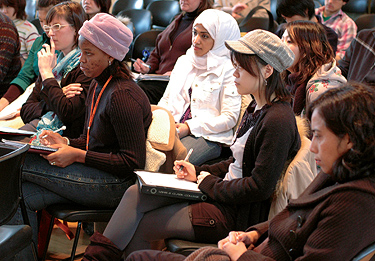Nation Focuses on Global Warming
Open gallery

A Lewis & Clark–based initiative captures national attention and spurs discussion of global warming solutions.
by Tom Krattenmaker
Eban Goodstein’s national teach-in on global warming solutions was supposed to be a one-time event—but participants had other ideas. The national response to the Lewis & Clark–based program left its creator, Professor of Economics Eban Goodstein, with little choice but to keep it going.
“We were so successful,” Goodstein says, “it was impossible to walk away.”
On January 31, Goodstein saw the realization of his dream to bring together students, citizens, and political and business leaders from around the country in a dialogue about solutions to global warming. In the massive national teach-in organized by Goodstein and a small staff, some 1,900 organizations—mainly colleges but also high schools, faith organizations, and businesses—tackled the issue in panels, performances, lectures, and the like. Also joining in the dialogue were 75 major political leaders, including House Speaker Nancy Pelosi and California Governor Arnold Schwarzenegger.
The on-the-ground events reached millions more via coverage by major media outlets including Time, Newsweek, the New York Times, and USA Today.
At Lewis & Clark, the daylong teach-in revolved around nearly three dozen sessions involving participants from the undergraduate college, the law school, and the graduate school. Panelists discussed “peak oil” (the peak of the planet’s oil production), obstacles to change, ecological tipping points, and a host of related topics.
Later that evening, Lewis & Clark had a large presence at the Portland-area summit event, attended by several thousand people at the University of Portland. Senior David Norse served on a student panel that asked questions of Oregon Governor Ted Kulongoski and other assembled political leaders, and U.S. Representative Earl Blumenauer BA ’70, JD ’76 addressed the crowd via a Webcast from a Democratic caucus retreat in Virginia.
Goodstein points out that besides accomplishing what the initiative’s name suggests–focusing Americans on global-warming solutions–the project provided valuable experience for thousands of up-and-coming student leaders who organized events on their campuses. “If there was ever a time when young people needed to become engaged,” he says, “it’s now.”
In the months since the event, Goodstein and a small staff have been busy planning a second national teach-in, tentatively set for February 2009. The effort will again be headquartered at Lewis & Clark.
Beginning this fall, Goodstein will involve more than a dozen Lewis & Clark undergraduates via an advanced-level course he’s teaching. In addition to studying the role of nonprofits in the U.S. economy, students in the course will take on projects in support of the 2009 teach-in.
Goodstein, who explored his passion for environmental preservation in his 2007 book Fighting for Love in the Century of Extinction: How Passion and Politics Can Stop Global Warming, credits Lewis & Clark for its role in Focus the Nation. By supporting the program, the institution played a leadership role in one of the defining issues of our time.
“The 2008 Focus the Nation event was a first step in getting Americans to face up to the challenge of a generation,” Goodstein says. “As one person said in a letter to us, we moved the needle. We got more Americans to not only take the issue seriously, but to begin envisioning our clean- and stable-energy future. Of course, there’s still much to be done.”
Goodstein likens the burgeoning global-warming solutions movement to the historic struggle for civil rights. “In 1960, Americans were fatalistic about segregation–they felt it would always be there,” he says. “Four years later, we had a national commitment to end the practice. Forty years later, an African American has become a serious candidate for the presidency.”
Goodstein is aiming to get even more than schools to participate in the 2009 event. “If we can reach that 5,000-schools mark,” he says, “that would represent a movement of a magnitude that would truly cross the barrier from fatalism to determination.”
More L&C Magazine Stories
Lewis & Clark Magazine is located in McAfee on the Undergraduate Campus.
MSC: 19
email magazine@lclark.edu
voice 503-768-7970
fax 503-768-7969
The L&C Magazine staff welcomes letters and emails from readers about topics covered in the magazine. Correspondence must include your name and location and may be edited.
Lewis & Clark Magazine
Lewis & Clark
615 S. Palatine Hill Road MSC 19
Portland OR 97219

